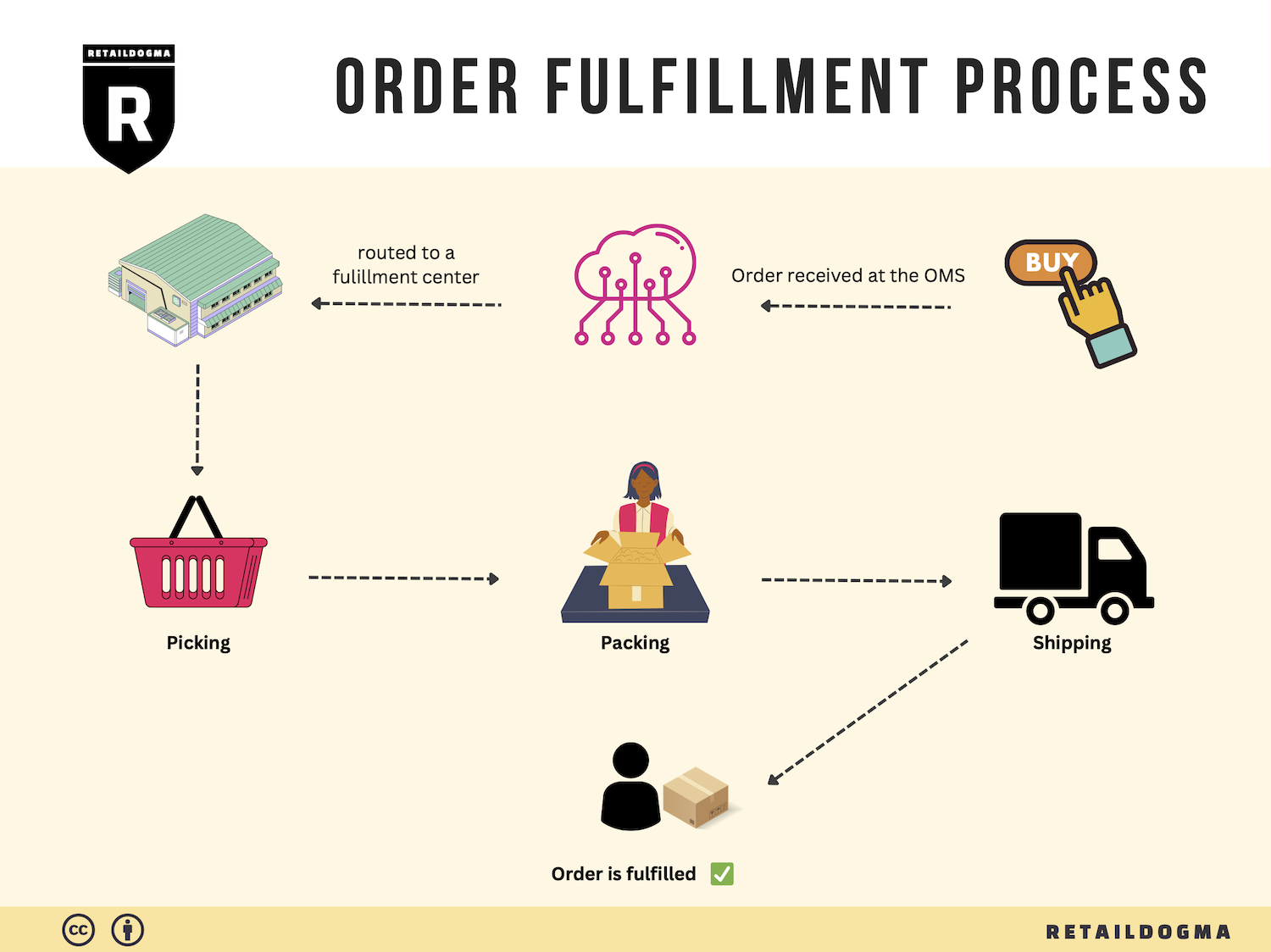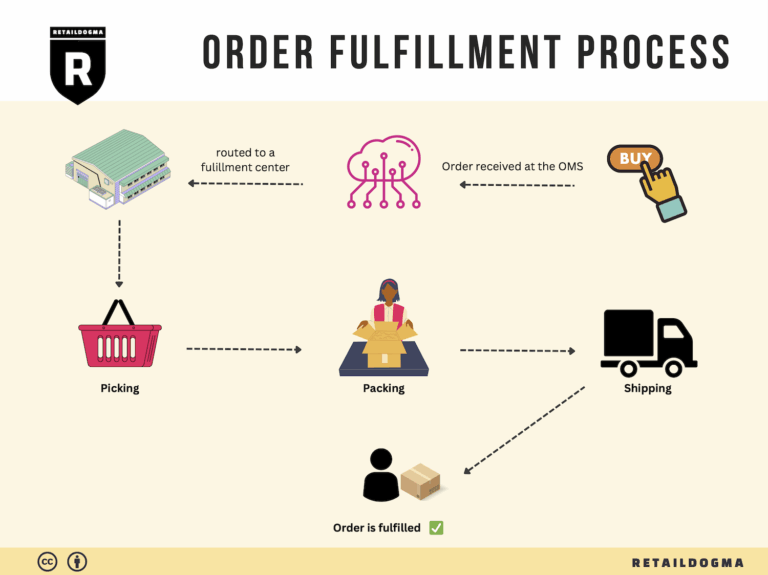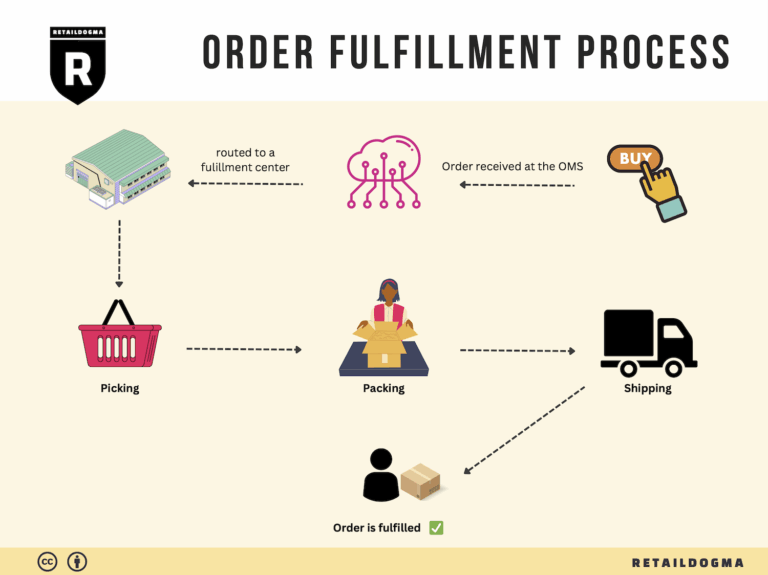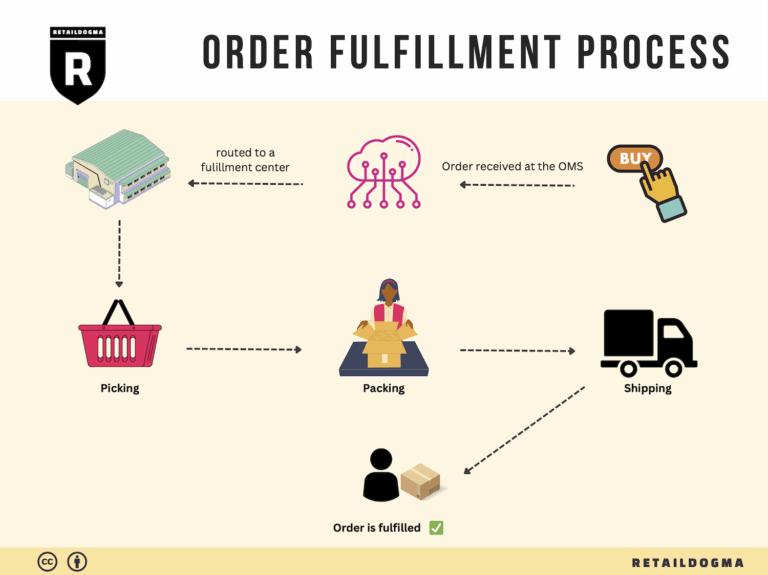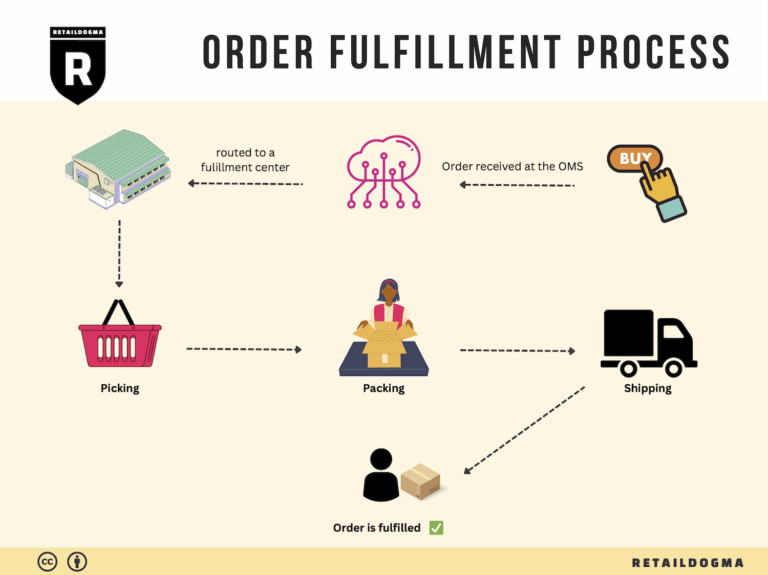Ecommerce Fulfillment Services: The Ultimate Guide (2025)
What is E-commerce Fulfillment? An Introduction for Growing Businesses
Understanding E-commerce Fulfillment
As your e-commerce business begins to grow, the excitement of increasing sales can quickly turn into a daunting challenge. One of the most common pain points for online retailers is managing the complexities of packing and shipping orders. The process of getting products from your warehouse to your customers can become overwhelming, leading to potential delays, errors, and dissatisfied customers. This is where effective e-commerce fulfillment comes into play.
E-commerce fulfillment is the comprehensive process of receiving, processing, and delivering orders to customers. It encompasses everything from inventory management to packing, shipping, and handling returns. A well-optimized fulfillment process is crucial for ensuring customer satisfaction and maintaining your business’s reputation.
This guide aims to demystify e-commerce fulfillment and provide you with practical insights to help you scale your logistics operations effectively. We will explore various fulfillment models, including Third-Party Logistics (3PL) and Fulfillment by Amazon (FBA), detailing the benefits and challenges associated with each. Understanding these models will empower you to make informed decisions that align with your business needs.
Moreover, we will delve into the core services involved in e-commerce fulfillment, such as warehousing, inventory management, order processing, and shipping. Knowing what services are available will allow you to tailor your fulfillment strategy to meet your customers’ expectations.
Choosing the right fulfillment partner is another critical aspect we will cover. The right partner can streamline your operations, enhance customer satisfaction, and ultimately contribute to your business’s growth. We will provide criteria for evaluating potential partners, ensuring you select one that aligns with your operational goals.
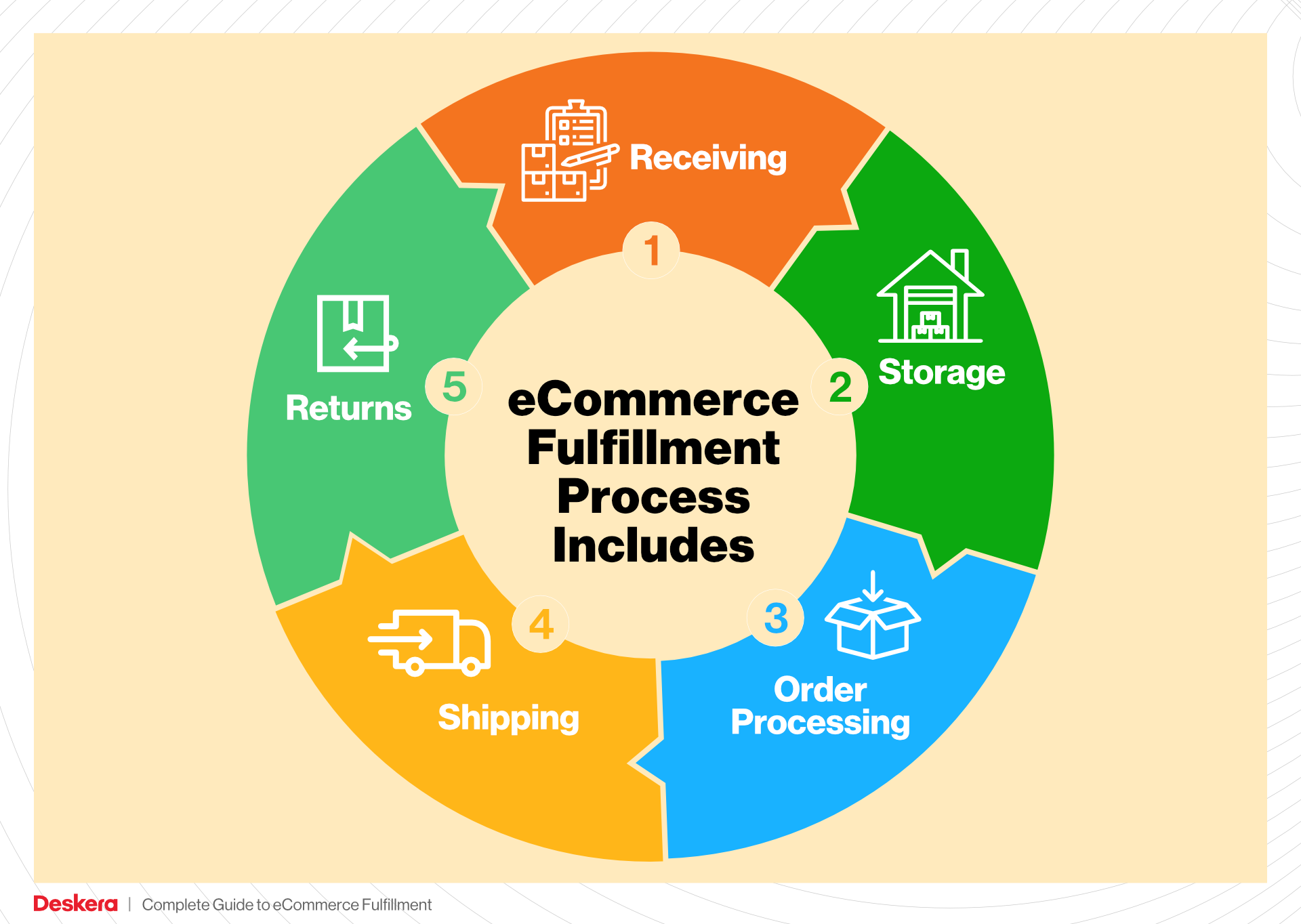
Lastly, we will discuss pricing structures associated with different fulfillment options. Understanding the costs involved will help you budget effectively and identify the most cost-efficient solutions for your business.
The goal of this guide is to empower you with the knowledge and tools necessary to make strategic decisions about your logistics and fulfillment processes. By optimizing your e-commerce fulfillment strategy, you can focus on what you do best: growing your business and delighting your customers.
What You’ll Learn In This Guide
- What is E-commerce Fulfillment? An Introduction for Growing Businesses
- The Order Fulfillment Process: From ‘Buy’ Button to Customer’s Door
- Comparing Fulfillment Models: In-House vs. 3PL vs. Dropshipping
- A Deep Dive into Amazon FBA: Pros, Cons, and Who It’s For
- Core Services Offered by Fulfillment Centers
- How to Choose a Fulfillment Partner: A 6-Point Checklist
- Understanding Fulfillment Pricing: A Breakdown of Common Fees
- Frequently Asked Questions (FAQs) about Fulfillment
- Conclusion: Is Outsourcing Fulfillment the Right Move for Your Business?
- Important Disclaimer
The Order Fulfillment Process: From ‘Buy’ Button to Customer’s Door
1. Receiving Inventory
The order fulfillment process begins with receiving inventory at the fulfillment center. Upon arrival, products are unloaded from delivery trucks and checked against purchase orders to ensure accuracy. This step is crucial as it establishes the foundation for inventory management. Each product is assigned a unique Stock Keeping Unit (SKU), which helps in tracking and managing stock levels effectively.
Proper receiving practices not only ensure that the correct items are accounted for but also minimize discrepancies and losses due to damaged goods or incorrect shipments. Timely and accurate receiving is vital for maintaining an efficient supply chain, as it directly impacts inventory accuracy and availability for order fulfillment.
2. Warehouse Storage
Once the inventory is received and verified, it is placed into designated storage locations within the warehouse. Efficient warehouse storage strategies, such as utilizing vertical space and organizing products based on demand, can significantly enhance the fulfillment process. This step is essential for ensuring that items are easily accessible for picking later on.
Key terms associated with warehouse storage include “bin locations” and “first-in, first-out (FIFO)” systems. Bin locations refer to specific spots where products are stored, while FIFO ensures that older stock is sold first, reducing the risk of obsolescence. Effective storage solutions contribute to a streamlined order fulfillment process by minimizing the time spent locating items during the picking stage.
3. Order Picking
Order picking is the process of selecting items from their storage locations to fulfill customer orders. This step is critical as it directly affects order accuracy and speed. Pick lists, which are generated based on customer orders, guide fulfillment associates in retrieving the correct items from the warehouse.
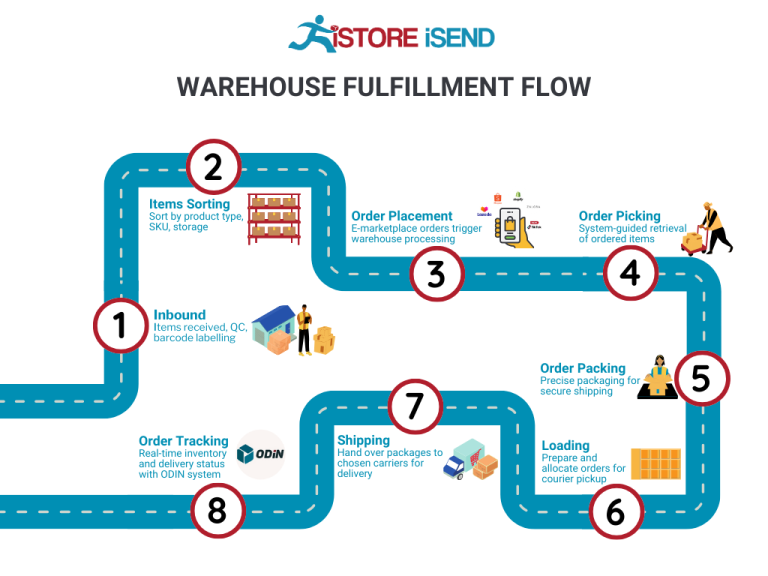
The efficiency of the picking process can be enhanced through various methods, such as batch picking, zone picking, or wave picking. Batch picking allows associates to gather items for multiple orders simultaneously, while zone picking divides the warehouse into sections for specific teams to manage. Streamlining the picking process reduces order cycle times and improves overall customer satisfaction.
4. Order Packing
After items have been picked, they are brought to the packing station, where they are prepared for shipment. This step involves checking the items for quality, packing them securely in boxes, and labeling them appropriately for delivery. Order packing is a vital stage in the fulfillment process, as it ensures that products arrive at the customer’s door in perfect condition.
Key terms related to packing include “packing slips” and “dimensional weight.” Packing slips provide a summary of the items included in the shipment, serving as a receipt for customers. Dimensional weight is a pricing technique used by carriers based on the volume of the package, which highlights the importance of efficient packing techniques to minimize shipping costs. Proper packing practices contribute to reducing returns and enhancing the overall customer experience.
5. Shipping & Delivery
The final step in the order fulfillment process is shipping and delivery. Once packages are packed and labeled, they are handed over to shipping carriers for distribution. This step is crucial as it determines how quickly and efficiently orders reach customers.
Understanding shipping options, costs, and delivery times can significantly impact customer satisfaction and retention. Key terms in this phase include “last mile delivery” and “shipping zones.” Last mile delivery refers to the final leg of the shipping journey, where packages are delivered from a local distribution center to the customer’s address. Shipping zones categorize delivery locations based on distance from the fulfillment center, influencing shipping rates and delivery times.
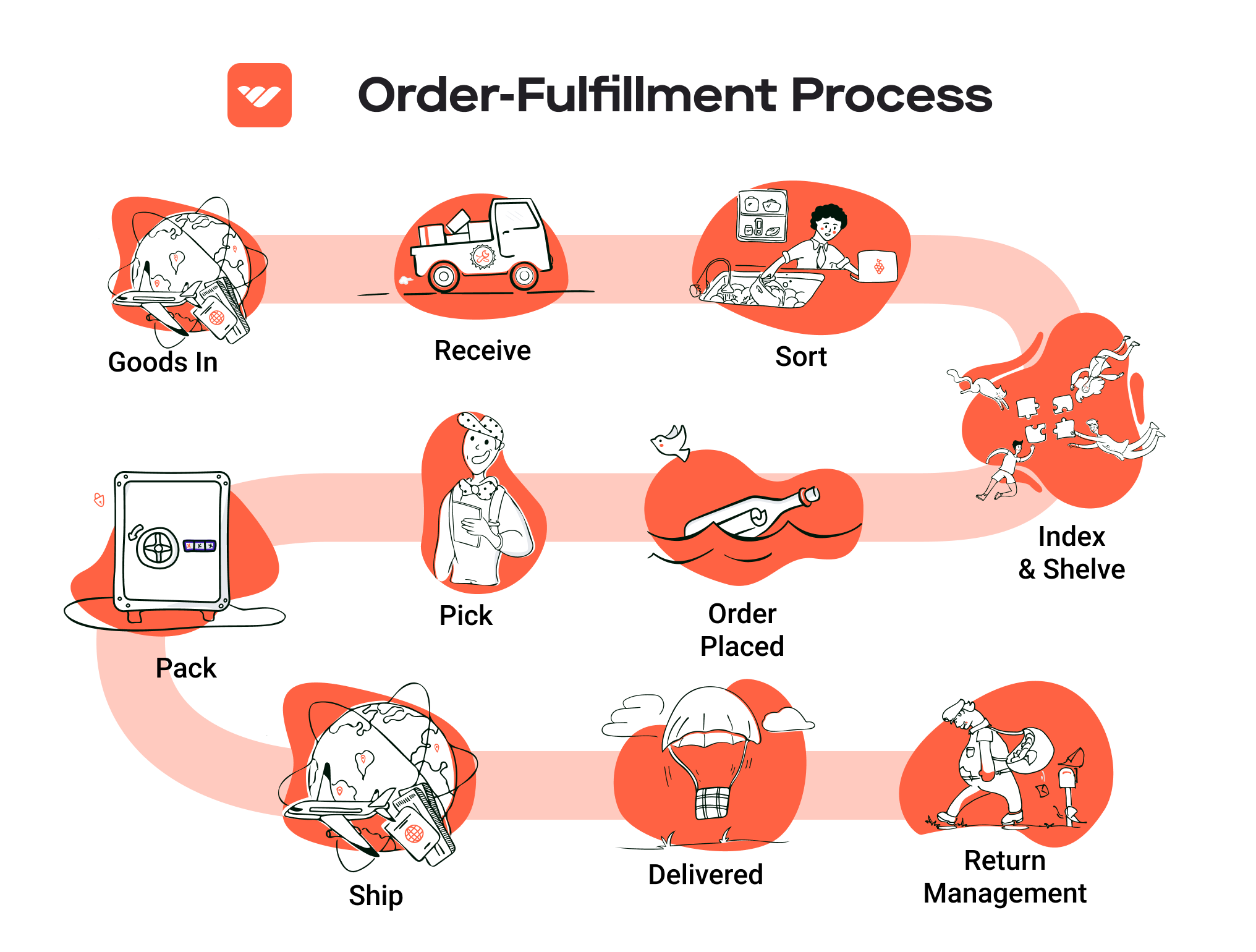
In conclusion, each step in the order fulfillment process is interconnected and plays a vital role in ensuring customer satisfaction. By optimizing these processes, e-commerce businesses can enhance operational efficiency, reduce costs, and ultimately scale their sales and logistics effectively.
Comparing Fulfillment Models: In-House vs. 3PL vs. Dropshipping
Fulfillment Model Comparison
| Model | Who Handles Inventory | Best For (Business Stage) | Key Advantage | Key Disadvantage |
|---|---|---|---|---|
| In-House Fulfillment | The business itself | Established businesses | Full control over inventory and operations | High overhead costs and resource demands |
| Third-Party Logistics (3PL) | A specialized logistics provider | Growing businesses | Scalability and expertise in logistics | Less control over inventory and fulfillment speed |
| Dropshipping | Supplier/vendor | Startups and small businesses | Low upfront investment and minimal risk | Lower profit margins and dependency on suppliers |
In-House Fulfillment
In-house fulfillment refers to the process where a business manages its own inventory, warehousing, and shipping operations. This model is ideal for established companies that have already built a customer base and can justify the investment in their logistics infrastructure. The primary advantage of in-house fulfillment is the complete control it offers over inventory management, order processing, and shipping times. Businesses can tailor their processes to meet specific customer needs, implement custom packaging, and maintain a high level of quality assurance.
However, managing fulfillment in-house comes with significant challenges. The overhead costs can be quite high, as it requires investment in warehouse space, staff, and technology. Additionally, businesses must manage the complexities of logistics, including inventory management, shipping logistics, and returns processing. For many small to medium-sized enterprises (SMEs), these resource demands can be overwhelming and divert focus from core business activities, particularly if the company is still in a growth phase.
Third-Party Logistics (3PL)
Third-party logistics (3PL) is a model where businesses outsource their fulfillment operations to specialized logistics providers. This can include warehousing, inventory management, order processing, and shipping. 3PL is particularly beneficial for growing businesses that require scalability without the burden of managing their logistics in-house. The main advantage of this model is that it allows businesses to tap into the expertise of logistics professionals, enabling faster shipping times, improved order accuracy, and potentially lower costs due to economies of scale.
On the downside, using a 3PL can result in less control over inventory and fulfillment processes. Companies must rely on their logistics partner to maintain quality and efficiency, which can lead to challenges if communication or operational issues arise. Additionally, businesses may face complexities in integrating their systems with those of the 3PL, which can create delays in order processing and fulfillment. For companies looking to maintain a strong brand identity, outsourcing fulfillment can also dilute their customer experience if the 3PL does not align with their values and standards.
Dropshipping
Dropshipping is a fulfillment model where a business sells products without holding inventory. Instead, when a product is sold, the business purchases the item from a third-party supplier who ships it directly to the customer. This model is particularly appealing for startups and small businesses, as it requires minimal upfront investment and reduces the risk associated with unsold inventory. Entrepreneurs can focus on marketing and customer engagement without the burden of managing logistics and warehousing.
However, dropshipping comes with its own set of challenges. The most significant drawback is the typically lower profit margins, as suppliers often charge a premium for handling fulfillment. Additionally, businesses are heavily reliant on their suppliers for inventory availability, quality control, and shipping speed. Any delays or errors on the supplier’s part can directly impact customer satisfaction and damage the business’s reputation. Furthermore, the lack of control over the fulfillment process means that businesses may struggle to provide a consistent brand experience, which is critical for customer loyalty and repeat business.
Conclusion
Choosing the right fulfillment model is crucial for the success of an e-commerce business. In-house fulfillment offers control but requires significant resources, while 3PL provides scalability and expertise at the cost of some control. Dropshipping minimizes risk and investment but can lead to lower margins and dependency on suppliers. Business owners must carefully assess their current stage, resources, and growth goals to determine which model aligns best with their operational strategy. By understanding the strengths and weaknesses of each fulfillment approach, entrepreneurs can make informed decisions that will support their growth and customer satisfaction.
A Deep Dive into Amazon FBA: Pros, Cons, and Who It’s For
What is Fulfillment by Amazon (FBA)?
Fulfillment by Amazon (FBA) is a service provided by Amazon that allows sellers to store their products in Amazon’s fulfillment centers. When a customer orders a product, Amazon takes care of storage, packaging, and shipping on behalf of the seller. This service not only helps sellers streamline their logistics but also provides access to Amazon’s vast customer base, enhancing visibility and sales potential.
The FBA process involves several key steps:
1. Product Listing: Sellers create listings for their products on the Amazon platform, indicating that they are using FBA.
2. Inventory Shipment: Sellers send their inventory to Amazon’s fulfillment centers. Amazon has multiple centers across the United States and globally, including a significant one in Bloomington, CA.
3. Storage: Amazon stores the products in their warehouses until an order is placed.
4. Order Fulfillment: Once an order is made, Amazon picks, packs, and ships the product directly to the customer.
5. Customer Service: Amazon handles all customer service inquiries and returns for FBA orders, freeing sellers from these responsibilities.
Pros of FBA
Prime Eligibility
One of the standout benefits of using FBA is the eligibility for Amazon Prime. Products fulfilled through FBA are marked with the Prime badge, making them more appealing to the millions of Prime members who prefer fast, free shipping. This can significantly increase conversion rates and overall sales.
Customer Trust
Amazon has established itself as a trusted name in e-commerce. By using FBA, sellers can leverage this trust. Customers are more likely to purchase items fulfilled by Amazon due to the perceived reliability and assurance of quality service. This can lead to higher customer satisfaction and repeat purchases.
Multi-Channel Fulfillment
FBA is not limited to Amazon’s marketplace. Sellers can use FBA to fulfill orders from other sales channels, such as their own websites or other e-commerce platforms. This flexibility allows for a more streamlined operations process and better inventory management.
Simplified Logistics
FBA simplifies logistics for sellers, as Amazon handles storage, packing, and shipping. This allows sellers to focus on other aspects of their business, such as product development and marketing. Additionally, Amazon’s global logistics network ensures timely delivery, enhancing customer satisfaction.
Scalability
With FBA, businesses can easily scale operations. Whether a seller has a few products or thousands, Amazon’s infrastructure can accommodate growth without requiring significant investment in logistics and warehousing.
Cons of FBA
High Fees
While FBA offers numerous benefits, it comes with costs that can eat into profit margins. Fees include storage fees for keeping inventory in Amazon’s warehouses and fulfillment fees for each order shipped. Sellers need to carefully calculate these costs to ensure they remain profitable.
Strict Inventory Rules
Amazon has strict policies regarding inventory management. Sellers must adhere to these rules to avoid penalties. This includes maintaining adequate stock levels and adhering to expiration dates for certain products. Failure to comply can result in additional fees or suspension from the platform.
Commingling Risks
FBA operates on a commingling model, meaning that the inventory of different sellers is stored together. While this helps Amazon optimize shipping, it also introduces risks. If a customer receives a defective or damaged product from another seller, it could reflect poorly on the original seller, potentially leading to negative reviews or account issues.
Limited Control
By using FBA, sellers relinquish some control over the fulfillment process. This includes aspects such as packaging and shipping times. Sellers must trust Amazon to maintain their brand’s integrity during these processes, which can be a concern for some businesses.
Complex Returns Management
Although Amazon handles returns for FBA orders, the process can sometimes be complex for sellers. Returned items may not always be in a sellable condition, and sellers may face challenges in managing restocking and returns effectively.
Who is FBA Best For?
Fulfillment by Amazon is best suited for various types of e-commerce businesses, particularly:
-
Small to Medium-Sized Sellers: Businesses that lack the resources to manage their own logistics can benefit significantly from FBA. It allows them to scale without the complexities of warehousing and shipping.
-
Brands with High Demand Products: Sellers with products that have consistent demand can maximize FBA’s advantages, particularly the Prime badge and customer trust.
-
Multi-Channel Sellers: Businesses that sell on multiple platforms can utilize FBA to streamline their fulfillment process across different channels, making inventory management more efficient.
-
Sellers Looking for Growth: Companies aiming to expand their reach and sales can leverage Amazon’s vast customer base and logistics network to grow their business.
-
Niche Products: Sellers with niche products that may not have widespread distribution can find a unique advantage in using FBA, as it allows them to reach a broader audience through Amazon.
In conclusion, while Fulfillment by Amazon offers significant advantages in terms of logistics, customer trust, and scalability, it is essential for sellers to weigh these benefits against the potential drawbacks, such as costs and loss of control. By understanding the nuances of FBA, e-commerce business owners can make informed decisions that align with their growth strategies.
Core Services Offered by Fulfillment Centers
Inventory Management & Warehousing
Inventory management and warehousing are foundational services provided by fulfillment centers, crucial for maintaining the flow of products in e-commerce operations. This service involves the systematic tracking of inventory levels, orders, sales, and deliveries. Fulfillment centers employ advanced technology and software systems to monitor stock levels in real-time, ensuring businesses have the right amount of product on hand to meet customer demand without overstocking.
The benefits of effective inventory management are manifold. Firstly, it minimizes the risk of stockouts, which can lead to lost sales and dissatisfied customers. By maintaining optimal inventory levels, businesses can ensure that they are always prepared to fulfill orders promptly. Additionally, accurate inventory tracking reduces excess stock, which ties up capital and increases storage costs. This efficiency not only saves money but also enhances operational agility, allowing businesses to respond swiftly to market changes or customer preferences.
Pick and Pack Services
Pick and pack services are essential for the order fulfillment process, wherein items are selected (picked) from inventory and packaged (packed) for shipment to customers. Fulfillment centers utilize sophisticated systems to streamline this process, often employing barcode scanning and automated picking technologies to enhance speed and accuracy.
For e-commerce businesses, the advantages of utilizing pick and pack services are significant. This service drastically reduces the time from order placement to delivery, which is critical in today’s fast-paced market where customer expectations for rapid fulfillment are high. Furthermore, outsourcing this function allows businesses to focus on core activities such as marketing and product development, rather than logistics. The precision offered by fulfillment centers also minimizes errors in order fulfillment, leading to higher customer satisfaction and repeat business.
Kitting and Assembly
Kitting and assembly services involve the grouping of individual items into a single kit or assembling various components into a final product before shipping. This service is particularly valuable for businesses that offer bundled products, seasonal items, or promotional kits. Fulfillment centers can efficiently handle the assembly of these kits, ensuring that they are packaged correctly and ready for sale.
The benefits of kitting and assembly services are particularly pronounced for e-commerce businesses looking to enhance their product offerings. By utilizing these services, companies can create unique product bundles that attract customers and increase average order values. Additionally, this service reduces the burden on internal teams, as fulfillment centers can handle the complexities of assembling and packaging products, allowing businesses to scale operations without the need for additional in-house resources. This flexibility can be crucial for businesses that experience seasonal spikes in demand or are looking to launch new products.
Returns Management (Reverse Logistics)
Returns management, or reverse logistics, is a vital service provided by fulfillment centers that focuses on handling product returns efficiently. This process includes the receiving, processing, and restocking of returned items. Fulfillment centers implement robust systems to manage returns, ensuring that the process is as seamless as possible for both the business and the customer.
For e-commerce businesses, effective returns management offers several key benefits. Firstly, it enhances customer satisfaction by providing a straightforward and hassle-free return process, which is a critical factor in retaining customers and encouraging repeat purchases. A streamlined returns process can also improve the overall customer experience, making it more likely that customers will recommend the business to others. Furthermore, efficient reverse logistics can reduce costs associated with returns, as fulfillment centers are adept at assessing returned products and determining whether they can be restocked, refurbished, or need to be disposed of. This capability not only minimizes losses but also contributes to sustainability efforts by reducing waste.
Conclusion
In summary, fulfillment centers provide a suite of core services that are essential for e-commerce businesses looking to optimize their operations and scale effectively. From inventory management and warehousing to pick and pack services, kitting and assembly, and returns management, these services not only enhance operational efficiency but also improve customer satisfaction and drive revenue growth. By leveraging the expertise and resources of fulfillment centers, businesses can focus on their core competencies while ensuring that their logistics and supply chain processes are handled with precision and professionalism.
How to Choose a Fulfillment Partner: A 6-Point Checklist
Location & Warehouse Network
Why It Matters
The geographical location of your fulfillment partner’s warehouses is crucial for optimizing shipping times and costs. A partner with strategically placed facilities can reduce transit times, enhance delivery speed, and minimize shipping expenses. Particularly for e-commerce businesses that aim for fast delivery, proximity to key markets can provide a significant competitive edge.
Questions to Ask
– Where are your warehouses located, and how do they align with my target customer demographics?
– How many fulfillment centers do you operate, and what is their capacity?
– Do you offer regional distribution options to help reduce shipping costs and times?
Technology & Integrations
Why It Matters
In today’s digital landscape, robust technology is essential for seamless operations. A fulfillment partner should provide an easy-to-use platform that integrates with your existing e-commerce systems (like Shopify, WooCommerce, or Amazon). This ensures real-time inventory tracking, order management, and data analytics, which are vital for making informed decisions.
Questions to Ask
– What technology platforms do you use for inventory management and order fulfillment?
– Can your system integrate with my current e-commerce platform? If so, how seamless is that integration?
– Do you offer real-time tracking for both inventory and shipments, and how is that information shared with clients?
Specializations (e.g., Cold Storage, Oversized Items)
Why It Matters
If your business deals with specific product types, such as perishables or oversized items, you’ll need a fulfillment partner with the right capabilities. Specialized services like cold storage or expertise in handling bulky items can prevent damage and ensure compliance with safety regulations, which is critical for customer satisfaction.
Questions to Ask
– Do you have specialized facilities for handling my product types (e.g., refrigerated storage, hazardous materials)?
– What processes do you have in place to ensure the safety and quality of specialized items?
– Can you accommodate unique packaging or shipping requirements for my products?
Scalability & Capacity
Why It Matters
As your business grows, your fulfillment needs will evolve. A good partner should be able to scale operations up or down efficiently to match your sales volume, ensuring that you can handle peak seasons without overextending your resources or incurring unnecessary costs.
Questions to Ask
– How do you handle fluctuations in order volume, especially during peak seasons?
– What is your maximum capacity, and how quickly can you ramp up operations if needed?
– Are there any limitations on the types or quantities of products you can store and fulfill?
Pricing and Contracts
Why It Matters
Understanding the cost structure of your fulfillment partner is essential for budgeting and profitability. It’s important to know not only the base fees but also any hidden costs associated with storage, order processing, or shipping. Clear contracts can prevent misunderstandings and ensure that both parties are aligned on expectations.
Questions to Ask
– What is your pricing structure, and what factors can influence these costs?
– Are there additional fees for services such as returns processing, special packaging, or expedited shipping?
– Can you provide a sample contract for review, including termination clauses and any conditions that might affect pricing?
Customer Support & Reviews
Why It Matters
The quality of customer support can make or break your relationship with a fulfillment partner. Responsive and knowledgeable support is essential for resolving issues quickly and maintaining smooth operations. Additionally, researching reviews and testimonials can provide insight into the partner’s reliability and service quality.
Questions to Ask
– What kind of customer support do you offer, and during what hours is it available?
– How do you handle issues such as lost shipments or inventory discrepancies?
– Can you provide references or case studies from similar businesses that have used your services?
By systematically evaluating potential fulfillment partners using this checklist, e-commerce business owners and managers can make informed decisions that align with their operational needs and growth strategies. The right partner will not only enhance logistics efficiency but also contribute to improved customer satisfaction and business scalability.
Understanding Fulfillment Pricing: A Breakdown of Common Fees
Initial Setup Fees
Initial setup fees are typically charged when you first start using a fulfillment service. These fees cover the costs associated with creating and configuring your account, integrating your inventory management systems, and establishing your logistics processes. Depending on the provider, this fee may also include the setup of your product listings and other necessary administrative tasks.
Calculating initial setup fees can vary widely among fulfillment centers. Generally, they may be a flat rate or based on the complexity of your operations. For instance, if you have a large catalog of products or require specific integrations with your e-commerce platform, you may face higher setup costs. It is essential to inquire about any potential hidden fees, as these can significantly impact your initial investment.
Receiving Fees
Receiving fees are charged when your products arrive at the fulfillment center. This fee covers the process of unloading, inspecting, and entering your inventory into the warehouse management system. Receiving fees can vary based on several factors, including the number of units received, the complexity of the receiving process, and the type of products being handled.
Typically, receiving fees are calculated per pallet or per unit. For example, if you send a shipment of 100 items, you might be charged a fee based on the number of items rather than a flat rate. It’s crucial to understand the receiving process and fees associated with it, especially if you plan to send frequent shipments.
Storage Fees (per pallet/bin)
Storage fees are incurred for keeping your inventory in the fulfillment center. These fees are typically calculated on a monthly basis and can be based on the volume of space your products occupy, often measured in pallets or bins. The fees vary depending on the type of storage—standard versus climate-controlled—and the location of the fulfillment center.
Storage fees are crucial to factor into your overall fulfillment costs, especially if you have a large inventory or products with longer shelf lives. Some fulfillment centers offer tiered pricing, where the cost per pallet decreases as you store more pallets, while others might charge a flat rate regardless of the volume. To optimize your storage costs, it’s beneficial to regularly review your inventory levels and adjust shipments accordingly.
Pick & Pack Fees (per item/order)
Pick and pack fees are charged for the process of selecting items from your inventory and preparing them for shipment. This fee typically covers the labor involved in picking the products, packing them securely, and labeling them for delivery. Pick and pack fees can be calculated per item or per order, depending on the fulfillment center’s pricing model.
For instance, if you have an order that includes five different items, you may pay a fee for each item picked and packed. Understanding the nuances of these fees is vital, as they can significantly affect your overall fulfillment costs, especially if you have a diverse product range. To minimize these costs, consider optimizing your product offerings and encouraging bulk purchases.
Shipping Fees
Shipping fees are incurred when your products are dispatched from the fulfillment center to your customers. These fees depend on various factors, including the destination, shipping method (standard, expedited, etc.), and the weight or dimensions of the package. Shipping fees can be one of the most variable costs in your fulfillment process, so it’s important to understand how they are calculated.
Many fulfillment centers negotiate shipping rates with carriers, which can lead to cost savings. Some may offer discounted rates based on the volume of shipments. Additionally, integrating shipping software can help you compare rates across different carriers and optimize your shipping strategy. Being proactive about shipping options can lead to significant savings and improved customer satisfaction.
Tips for Getting an Accurate Quote
-
Provide Detailed Information: When requesting quotes from fulfillment centers, provide comprehensive details about your inventory, expected order volume, and specific fulfillment needs.
-
Ask About All Fees: Inquire about all potential fees, including hidden costs associated with initial setup, receiving, storage, and shipping. Understanding the full picture will help you budget accurately.
-
Evaluate Different Providers: Don’t settle for the first quote you receive. Compare multiple fulfillment centers to find one that meets your needs at a competitive price.
-
Review Terms and Conditions: Carefully read the terms and conditions of the fulfillment service to ensure there are no surprises regarding fees or service limitations.
-
Negotiate: Many fulfillment centers are open to negotiation, especially if you can provide them with projected order volumes. Don’t hesitate to discuss your needs and explore potential cost-saving opportunities.
By understanding these common fulfillment pricing models and strategically approaching your fulfillment partner, you can better manage your logistics costs and scale your e-commerce operations effectively.
Frequently Asked Questions (FAQs) about Fulfillment
1. What is the Bloomington Amazon Fulfillment Center?
The Bloomington Amazon Fulfillment Center, located at 18025 Slover Ave, Bloomington, CA, is a large-scale warehouse facility dedicated to the storage and shipping of a wide variety of products for Amazon. This center plays a vital role in ensuring efficient logistics and timely delivery of customer orders across the region, leveraging advanced technology and a streamlined process to enhance customer satisfaction.
2. What’s the difference between a warehouse and a fulfillment center?
While both warehouses and fulfillment centers are used for storing products, their functions differ significantly. A warehouse primarily focuses on storing inventory for long periods, whereas a fulfillment center is designed to facilitate the rapid processing and shipping of orders directly to customers. Fulfillment centers often have advanced systems in place for picking, packing, and shipping orders quickly to meet consumer demands.
3. What is a 3PL (Third-Party Logistics)?
A Third-Party Logistics provider (3PL) is a service that allows businesses to outsource their logistics operations. This includes warehousing, fulfillment, and transportation services. By partnering with a 3PL, e-commerce businesses can leverage the expertise and resources of established logistics companies, which can help reduce costs, increase efficiency, and improve service delivery.
4. How much do fulfillment services cost?
The cost of fulfillment services can vary widely based on several factors, including the size and weight of the products, the volume of orders, and the specific services provided (like storage, packaging, and shipping). On average, businesses may expect to pay anywhere from $1 to $5 per order, plus storage fees that can range from $0.10 to $0.50 per cubic foot per month. It’s essential to evaluate your specific needs and get quotes from multiple providers to find the best fit for your budget.
5. How does the Bloomington Amazon Fulfillment Center improve delivery speed?
The Bloomington Amazon Fulfillment Center utilizes advanced technology, including robotics and AI, to enhance operational efficiency. This center is strategically located to optimize shipping routes and reduce transit times. Additionally, the facility operates around the clock, enabling a continuous workflow that supports quick order processing and delivery.
6. Can small businesses use the Bloomington Amazon Fulfillment Center?
Yes, small businesses can utilize the Bloomington Amazon Fulfillment Center through Amazon’s Fulfillment by Amazon (FBA) program. This service allows small to medium-sized e-commerce sellers to store their products in Amazon’s fulfillment centers, where Amazon takes care of storage, packing, shipping, and customer service, allowing sellers to focus on growing their business.
7. What types of products can be stored at the Bloomington Fulfillment Center?
The Bloomington Amazon Fulfillment Center can store a wide range of products, including electronics, household goods, clothing, and more. However, there are restrictions on certain items, such as hazardous materials, perishables, and oversized items that may not fit within Amazon’s fulfillment guidelines. It’s important for sellers to consult Amazon’s policies to ensure compliance.
8. How does inventory management work at the Bloomington Amazon Fulfillment Center?
Inventory management at the Bloomington Fulfillment Center is facilitated through sophisticated software systems that track stock levels, order processing, and shipping logistics. Sellers using Amazon FBA can monitor their inventory levels through their Amazon Seller Central account, receive alerts for low stock, and manage restocking efficiently to avoid stockouts.
9. What are the benefits of using the Bloomington Amazon Fulfillment Center for order fulfillment?
Using the Bloomington Fulfillment Center offers several benefits, including access to Amazon’s extensive logistics network, fast shipping options (like Prime delivery), and reduced operational burdens for businesses. Additionally, sellers can leverage Amazon’s customer service and returns management, which enhances the overall customer experience.
10. How can I get started with fulfillment services at the Bloomington Amazon Fulfillment Center?
To get started with fulfillment services at the Bloomington Amazon Fulfillment Center, you can sign up for Amazon’s Fulfillment by Amazon (FBA) program through your Amazon Seller Central account. After setting up your account, you can create product listings, prepare your inventory, and ship your products to the Bloomington facility. Amazon provides detailed guidelines to help you through the process.
Conclusion: Is Outsourcing Fulfillment the Right Move for Your Business?
Evaluating the Benefits of Outsourcing Fulfillment
Outsourcing your fulfillment processes can be a game-changer for your e-commerce business. By leveraging a fulfillment service, you can save valuable time, allowing you to focus on core business activities such as marketing, product development, and customer engagement. This shift can dramatically enhance your operational efficiency, freeing you from the complexities of inventory management and shipping logistics.
Scalability is another critical advantage. As your sales grow, so do your fulfillment needs. A fulfillment partner can seamlessly adjust to fluctuations in order volume, ensuring that you can scale your operations without the headaches associated with hiring and training new staff or expanding your warehouse space. This flexibility is particularly beneficial during peak seasons, such as holidays or sales events, where demand can surge unexpectedly.
Moreover, fulfillment centers bring a wealth of expertise to the table. From advanced technology that optimizes inventory management to established shipping networks that ensure timely deliveries, partnering with a professional fulfillment service can enhance the customer experience and increase your competitive edge in the market.
However, the success of outsourcing fulfillment hinges on selecting the right partner. It’s crucial to evaluate potential fulfillment services based on their capabilities, technology, and track record. Conducting thorough due diligence will help you find a partner that aligns with your business goals and values.
Strategic Call to Action
To determine if a fulfillment partner is the right next step for your business, consider conducting a comprehensive audit of your current shipping process. Assess your order fulfillment speed, accuracy, and customer satisfaction levels. By understanding your strengths and weaknesses, you can make an informed decision about whether outsourcing fulfillment is the strategic move needed to accelerate your growth.
Important Disclaimer
⚠️ Important Disclaimer
The information in this guide is for educational purposes. Fulfillment services, pricing, and platform features change frequently. Always conduct your own due diligence and consult with providers directly before making business decisions.
